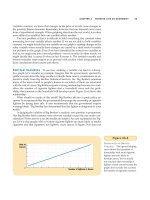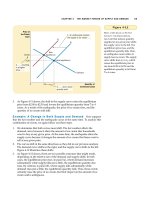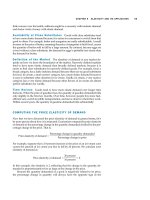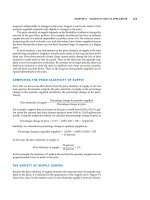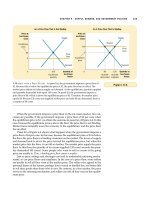Tài liệu Ten Principles of Economics - Part 6 pdf
Bạn đang xem bản rút gọn của tài liệu. Xem và tải ngay bản đầy đủ của tài liệu tại đây (227.4 KB, 10 trang )
CHAPTER 3 INTERDEPENDENCE AND THE GAINS FROM TRADE 53
anything best. To solve this puzzle, we need to look at the principle of comparative
advantage.
As a first step in developing this principle, consider the following question: In
our example, who can produce potatoes at lower cost—the farmer or the rancher?
There are two possible answers, and in these two answers lie both the solution to
our puzzle and the key to understanding the gains from trade.
ABSOLUTE ADVANTAGE
One way to answer the question about the cost of producing potatoes is to com-
pare the inputs required by the two producers. The rancher needs only 8 hours to
produce a pound of potatoes, whereas the farmer needs 10 hours. Based on this in-
formation, one might conclude that the rancher has the lower cost of producing
potatoes.
Economists use the term absolute advantage when comparing the productiv-
ity of one person, firm, or nation to that of another. The producer that requires a
smaller quantity of inputs to produce a good is said to have an absolute advantage
in producing that good. In our example, the rancher has an absolute advantage
both in producing potatoes and in producing meat, because she requires less time
than the farmer to produce a unit of either good.
OPPORTUNITY COST AND COMPARATIVE ADVANTAGE
There is another way to look at the cost of producing potatoes. Rather than com-
paring inputs required, we can compare the opportunity costs. Recall from Chap-
ter 1 that the opportunity cost of some item is what we give up to get that item. In
our example, we assumed that the farmer and the rancher each spend 40 hours a
week working. Time spent producing potatoes, therefore, takes away from time
available for producing meat. As the rancher and farmer change their allocations
of time between producing the two goods, they move along their production pos-
sibility frontiers; in a sense, they are using one good to produce the other. The op-
portunity cost measures the tradeoff that each of them faces.
Let’s first consider the rancher’s opportunity cost. Producing 1 pound of pota-
toes takes her 8 hours of work. When the rancher spends that 8 hours producing
potatoes, she spends 8 hours less producing meat. Because the rancher needs only
1 hour to produce 1 pound of meat, 8 hours of work would yield 8 pounds of meat.
Hence, the rancher’s opportunity cost of 1 pound of potatoes is 8 pounds of meat.
Now consider the farmer’s opportunity cost. Producing 1 pound of potatoes
takes him 10 hours. Because he needs 20 hours to produce 1 pound of meat, 10
hours would yield 1/2 pound of meat. Hence, the farmer’s opportunity cost of 1
pound of potatoes is 1/2 pound of meat.
Table 3-3 shows the opportunity cost of meat and potatoes for the two pro-
ducers. Notice that the opportunity cost of meat is the inverse of the opportunity
cost of potatoes. Because 1 pound of potatoes costs the rancher 8 pounds of meat,
1 pound of meat costs the rancher 1/8 pound of potatoes. Similarly, because 1
pound of potatoes costs the farmer 1/2 pound of meat, 1 pound of meat costs the
farmer 2 pounds of potatoes.
Economists use the term comparative advantage when describing the oppor-
tunity cost of two producers. The producer who has the smaller opportunity cost
absolute advantage
the comparison among producers of a
good according to their productivity
opportunity cost
whatever must be given up to obtain
some item
comparative advantage
the comparison among producers
of a good according to their
opportunity cost
54 PART ONE INTRODUCTION
of producing a good—that is, who has to give up less of other goods to produce
it—is said to have a comparative advantage in producing that good. In our exam-
ple, the farmer has a lower opportunity cost of producing potatoes than the
rancher (1/2 pound versus 8 pounds of meat). The rancher has a lower opportu-
nity cost of producing meat than the farmer (1/8 pound versus 2 pounds of pota-
toes). Thus, the farmer has a comparative advantage in growing potatoes, and the
rancher has a comparative advantage in producing meat.
Notice that it would be impossible for the same person to have a comparative
advantage in both goods. Because the opportunity cost of one good is the inverse
of the opportunity cost of the other, if a person’s opportunity cost of one good is
relatively high, his opportunity cost of the other good must be relatively low. Com-
parative advantage reflects the relative opportunity cost. Unless two people have
exactly the same opportunity cost, one person will have a comparative advantage
in one good, and the other person will have a comparative advantage in the other
good.
COMPARATIVE ADVANTAGE AND TRADE
Differences in opportunity cost and comparative advantage create the gains from
trade. When each person specializes in producing the good for which he or she has
a comparative advantage, total production in the economy rises, and this increase
in the size of the economic pie can be used to make everyone better off. In other
words, as long as two people have different opportunity costs, each can benefit
from trade by obtaining a good at a price lower than his or her opportunity cost of
that good.
Consider the proposed deal from the viewpoint of the farmer. The farmer gets
3 pounds of meat in exchange for 1 pound of potatoes. In other words, the farmer
buys each pound of meat for a price of 1/3 pound of potatoes. This price of meat
is lower than his opportunity cost for 1 pound of meat, which is 2 pounds of pota-
toes. Thus, the farmer benefits from the deal because he gets to buy meat at a good
price.
Now consider the deal from the rancher’s viewpoint. The rancher buys 1
pound of potatoes for a price of 3 pounds of meat. This price of potatoes is lower
than her opportunity cost of 1 pound of potatoes, which is 8 pounds of meat. Thus,
the rancher benefits because she gets to buy potatoes at a good price.
These benefits arise because each person concentrates on the activity for which
he or she has the lower opportunity cost: The farmer spends more time growing
potatoes, and the rancher spends more time producing meat. As a result, the total
production of potatoes and the total production of meat both rise, and the farmer
Table 3-3
T
HE
O
PPORTUNITY
C
OST OF
M
EAT AND
P
OTATOES
O
PPORTUNITY
C
OST OF
:
1 P
OUND OF
M
EAT
1 P
OUND OF
P
OTATOES
F
ARMER
2 lbs potatoes 1/2 lb meat
R
ANCHER
1/8 lb potatoes 8 lbs meat
CHAPTER 3 INTERDEPENDENCE AND THE GAINS FROM TRADE 55
and rancher share the benefits of this increased production. The moral of the story
of the farmer and the rancher should now be clear: Trade can benefit everyone in so-
ciety because it allows people to specialize in activities in which they have a comparative
advantage.
QUICK QUIZ: Robinson Crusoe can gather 10 coconuts or catch 1 fish per
hour. His friend Friday can gather 30 coconuts or catch 2 fish per hour. What is
Crusoe’s opportunity cost of catching one fish? What is Friday’s? Who has an
absolute advantage in catching fish? Who has a comparative advantage in
catching fish?
APPLICATIONS OF COMPARATIVE ADVANTAGE
The principle of comparative advantage explains interdependence and the gains
from trade. Because interdependence is so prevalent in the modern world, the
principle of comparative advantage has many applications. Here are two exam-
ples, one fanciful and one of great practical importance.
Economists have long under-
stood the principle of compara-
tive advantage. Here is how the
great economist Adam Smith
put the argument:
It is a maxim of every
prudent master of a family,
never to attempt to make
at home what it will cost
him more to make than to
buy. The tailor does not
attempt to make his own
shoes, but buys them of the shoemaker. The shoemaker
does not attempt to make his own clothes but employs a
tailor. The farmer attempts to make neither the one nor
the other, but employs those different artificers. All of
them find it for their interest to employ their whole
industry in a way in which they have some advantage over
their neighbors, and to purchase with a part of its
produce, or what is the same thing, with the price of part
of it, whatever else they have occasion for.
This quotation is from Smith’s 1776 book, An Inquiry into
the Nature and Causes of the Wealth of Nations, which was
a landmark in the analysis of trade
and economic interdependence.
Smith’s book inspired David
Ricardo, a millionaire stockbroker,
to become an economist. In his
1817 book, Principles of Political
Economy and Taxation, Ricardo de-
veloped the principle of compara-
tive advantage as we know it today.
His defense of free trade was not a
mere academic exercise. Ricardo
put his economic beliefs to work as
a member of the British Parliament,
where he opposed the Corn Laws,
which restricted the import of grain.
The conclusions of Adam Smith and David Ricardo on
the gains from trade have held up well over time. Although
economists often disagree on questions of policy, they are
united in their support of free trade. Moreover, the central
argument for free trade has not changed much in the past
two centuries. Even though the field of economics has
broadened its scope and refined its theories since the time
of Smith and Ricardo, economists’ opposition to trade re-
strictions is still based largely on the principle of compara-
tive advantage.
D
AVID
R
ICARDO
FYI
The Legacy of
Adam Smith
and David
Ricardo
56 PART ONE INTRODUCTION
SHOULD TIGER WOODS MOW HIS OWN LAWN?
Tiger Woods spends a lot of time walking around on grass. One of the most tal-
ented golfers of all time, he can hit a drive and sink a putt in a way that most ca-
sual golfers only dream of doing. Most likely, he is talented at other activities too.
For example, let’s imagine that Woods can mow his lawn faster than anyone else.
But just because he can mow his lawn fast, does this mean he should?
To answer this question, we can use the concepts of opportunity cost and com-
parative advantage. Let’s say that Woods can mow his lawn in 2 hours. In that same
2 hours, he could film a television commercial for Nike and earn $10,000. By con-
trast, Forrest Gump, the boy next door, can mow Woods’s lawn in 4 hours. In that
same 4 hours, he could work at McDonald’s and earn $20.
In this example, Woods’s opportunity cost of mowing the lawn is $10,000 and
Forrest’s opportunity cost is $20. Woods has an absolute advantage in mowing
lawns because he can do the work in less time. Yet Forrest has a comparative ad-
vantage in mowing lawns because he has the lower opportunity cost.
A
COMMON BARRIER TO FREE TRADE
among countries is tariffs, which are
taxes on the import of goods from
abroad. In the following opinion col-
umn, economist Douglas Irwin dis-
cusses a recent example of their use.
Lamb Tariffs Fleece
U.S. Consumers
B
Y
D
OUGLAS
A. I
RWIN
President Clinton dealt a serious blow to
free trade last Wednesday, when he an-
nounced that the U.S. would impose stiff
import tariffs on lamb from Australia and
New Zealand. His decision undercuts
American leadership and makes a mock-
ery of the administration’s claims that it
favors free and fair trade.
U.S. sheep producers have long
been dependent on government. For
more than half a century, until Congress
enacted farm-policy reforms in 1995,
they received subsidies for wool. Having
lost that handout, saddled with high
costs and inefficiencies, and facing do-
mestic competition from chicken, beef,
and pork, sheep producers sought to
stop foreign competition by filing for im-
port relief.
Almost all U.S. lamb imports come
from Australia and New Zealand, major
agricultural producers with a crushing
comparative advantage. New Zealand
has fewer than four million people but as
many as 60 million sheep (compared
with about seven million sheep in the
U.S.). New Zealand’s farmers have in-
vested substantial resources in new
technology and effective marketing,
making them among the most efficient
producers in the world. New Zealand
also eliminated domestic agricultural
subsidies in the free-market reforms of
the 1950s, and is a free-trading country,
on track to eliminate all import tariffs by
2006.
Rather than emulate this example,
the American Sheep Industry Asso-
ciation, among others, filed an “escape
clause” petition under the Trade Act
of 1974, which allows temporary
“breathing space” protection to import-
competing industries. Under the escape-
clause provision, a petitioning industry is
required to present an adjustment plan
to ensure that it undertakes steps to be-
come competitive in the future. The tariff
protection is usually limited and sched-
uled to be phased out.
The U.S. International Trade Com-
mission determines whether imports are
a cause of “serious injury” to the do-
mestic industry and, if so, proposes a
remedy, which the president has full dis-
cretion to adopt, change or reject. In
February, the ITC did not find that the do-
mestic industry had suffered “serious in-
jury,” but rather adopted the weaker
ruling that imports were “a substantial
IN THE NEWS
Who has a Comparative
Advantage in
Producing Lamb?
CHAPTER 3 INTERDEPENDENCE AND THE GAINS FROM TRADE 57
The gains from trade in this example are tremendous. Rather than mowing his
own lawn, Woods should make the commercial and hire Forrest to mow the lawn.
As long as Woods pays Forrest more than $20 and less than $10,000, both of them
are better off.
SHOULD THE UNITED STATES TRADE
WITH OTHER COUNTRIES?
Just as individuals can benefit from specialization and trade with one another, as
the farmer and rancher did, so can populations of people in different countries.
Many of the goods that Americans enjoy are produced abroad, and many of the
goods produced in the United States are sold abroad. Goods produced abroad and
sold domestically are called imports. Goods produced domestically and sold
abroad are called exports.
cause of threat of serious injury.” The
ITC did not propose to roll back imports,
only to impose a 20% tariff (declining
over four years) on imports above last
year’s levels.
The administration at first appeared
to be considering less restrictive mea-
sures. Australia and New Zealand even
offered financial assistance to the U.S.
producers, and the administration de-
layed any announcement and appeared
to be working toward a compromise. But
these hopes were completely dashed
with the shocking final decision, in which
the administration capitulated to the de-
mands of the sheep industry and its ad-
vocates in Congress.
The congressional charge was led
by Sen. Max Baucus (D., Mont.), a
member of the Agriculture Committee
whose sister, a sheep producer, had ap-
peared before the ITC to press for higher
tariffs. The administration opted for . . .
[the following:] On top of existing tariffs,
the president imposed a 9% tariff on
all
imports in the first year (declining to 6%
and then 3% in years two and three), and
a whopping 40% tariff on imports above
last year’s levels (dropping to 32% and
24%). . . .
The American Sheep Industry Asso-
ciation’s president happily announced
that the move will “bring some stability
to the market.” Whenever producers
speak of bringing stability to the market,
you know that consumers are getting
fleeced.
The lamb decision, while little no-
ticed at home, has been closely followed
abroad. The decision undercuts the ad-
ministration’s free-trade rhetoric and
harms its efforts to get other countries
to open up their markets. Some import
relief had been expected, but not so
clearly protectionist as what finally mate-
rialized. The extreme decision has out-
raged farmers in Australia and New
Zealand, and officials there have vowed
to take the U.S. to a WTO dispute set-
tlement panel.
The administration’s timing could
not have been worse. The decision came
right after an Asia Pacific Economic Co-
operation summit reaffirmed its commit-
ment to reduce trade barriers, and a few
months before the World Trade Organi-
zation’s November meeting in Seattle,
where the WTO is to launch a new round
of multilateral trade negotiations. A prin-
cipal U.S. objective at the summit is the
reduction of agricultural protection in Eu-
rope and elsewhere.
In 1947, facing an election the next
year, President Truman courageously re-
sisted special interest pressure and ve-
toed a bill to impose import quotas on
wool, which would have jeopardized the
first postwar multilateral trade negotia-
tions due to start later that year. In con-
trast, Mr. Clinton, though a lame duck,
caved in to political pressure. If the U.S.,
whose booming economy is the envy of
the world, cannot resist protectionism,
how can it expect other countries to
do so?
S
OURCE
: The Wall Street Journal, July 12, 1999,
p. A28.
imports
goods produced abroad and sold
domestically
exports
goods produced domestically and
sold abroad
